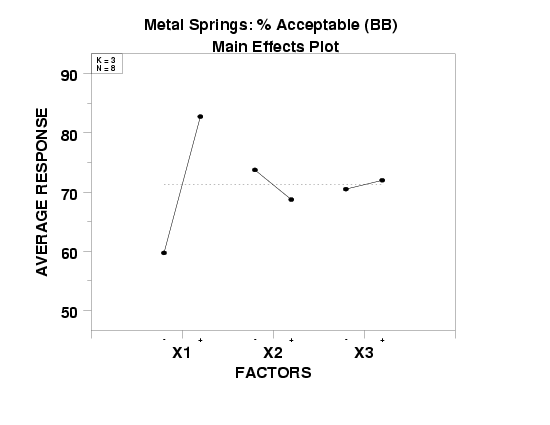5.5. Advanced topics
5.5.9. An EDA approach to experimental design
5.5.9.3. |
DOE mean plot |
- What is the ranked list of factors (not including the interactions)? The ranking is from the most important factor to least important factor.
- What is the best setting for each of the k factors?
A factor can be important if it leads to a significant shift in the location of the response variable as we go from the "-" setting of the factor to the "+" setting of the factor. Alternatively, a factor can be important if it leads to a significant change in variation (spread) as we go from the "-" to the "+" settings. Both definitions are relevant and acceptable. The default definition of "important" in engineering/scientific applications is the former (shift in location). Unless specified to the contrary, when a factor is claimed to be important, the implication is that the factor caused a large location shift in the response.
In this context, a factor setting is best if it results in a typical response that is closest (in location) to the desired project goal (that is, a maximization, minimization, or hitting a target). This desired project goal is an engineering, not a statistical, question, and so the desired optimization goal must be overtly specified by the engineer.
Given the above two definitions of important and best, the DOE mean plot is a useful tool for determining the important factors and for determining the best settings.
An alternate name for the DOE mean plot is the "main effects plot".
- Primary: A ranked list of the factors (not including interactions) from most important to least important.
- Secondary: The best setting for each of the k factors.
- Vertical Axis: The mean response for a given setting ("-" or "+") of a factor, for each of the k factors.
- Horizontal Axis: The k factors and the two settings ("-" and "+") within each factor.
The DOE mean plot is actually a sequence of k such plots, with one mean plot for each factor. To assist in comparability and relative importance, all of the mean plots are on the same scale.
- A ranked list of factors from most important to least important.
- The best settings for each factor (on average).
For each of the k factors, as we go from the "-" setting to the "+" setting for the factor, is there a shift in location of the average response?
If yes, we would like to identify the factor with the biggest shift (the "most important factor"), the next biggest shift (the "second most important factor"), and so on until all factors are accounted for.
Since we are only plotting the means and each factor has identical (-,+) = (-1,+1) coded factor settings, the above simplifies to
- What factor has the steepest line? This is the most important factor.
- The next steepest line? This is the second most important factor.
- Continue for the remaining factors.
Best Settings (on Average):
For each of the k factors, which setting (- or +) yields the "best" response?
In order to answer this, the engineer must first define "best". This is done with respect to the overall project goal in conjunction with the specific response variable under study. For some experiments, "best" means we are trying to maximize the response (e.g., maximizing the speed of a chip). For other experiments, "best" means we are trying to minimize the response (e.g., semiconductor chip scrap). For yet other experiments, "best" means we are trying to hit a specific target (e.g., designing a resistor to match a specified resistance). Thus the definition of "best" is a precursor to the determination of best settings.
For example, suppose the analyst is attempting to maximize the response. In that case, the analyst would proceed as follows:
- For factor 1, what setting (- or +) has the largest average response?
- For factor 2, what setting (- or +) has the largest average response?
- Continue for the remaining factors.
-
(x1best, x2best, ..., xkbest)
This candidate for best settings is based on the averages. This k-vector of best settings should be similar to that obtained from the DOE scatter plot, though the DOE mean plot is easier to interpret.
- Ranked list of factors (excluding interactions):
- X1 (most important). Qualitatively, this factor looks definitely important.
- X2 (of lesser importantance). Qualitatively, this factor is a distant second to X1.
- X3 (unimportant). Qualitatively, this factor appears to be unimportant.
- Best settings (on average):
-
(X1, X2, X3) = (+, -, +) = (+1, -1, +1)


